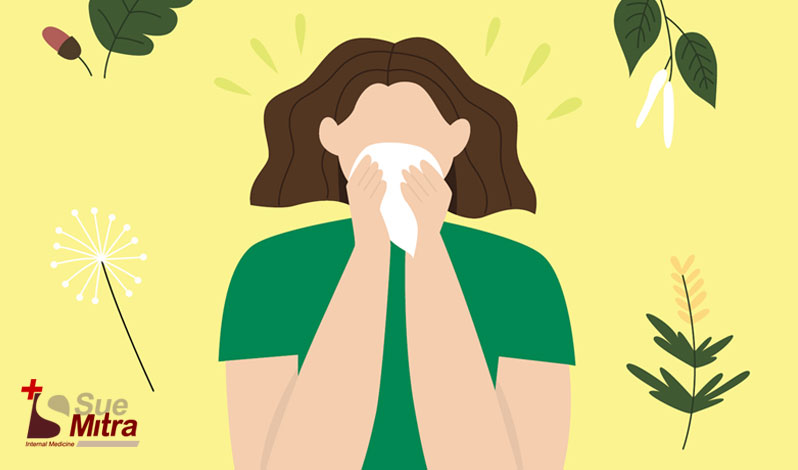
24, Apr 2023
Some people suffer from seasonal allergies, such as hay fever, during spring. Common symptoms of spring allergies include sneezing, itchy eyes, runny nose, coughing, and congestion. To reduce the severity of spring allergies, people can take steps to limit their exposure to allergens, such as avoiding outdoor activities when the pollen count is high, wearing a face mask when outdoors, and keeping windows closed during peak pollen times. Additionally, people can take medications such as antihistamines to reduce the symptoms of allergies.
Spring Allergy Symptoms
Sneezing: Sneezing is a most common symptom of spring allergies. It is caused by the body's response to allergens such as pollen, dust, and pet dander. If you are sneezing due to spring allergies, you may also experience an itchy nose, eyes, and throat.
Itchy Eyes: Itchy eyes are a common symptom of spring allergies. Allergies can cause the eyes to become red and itchy due to the body's response to allergens such as pollen, dust, and pet dander. To reduce the severity of itchy eyes, people can take antihistamines or use eye drops that contain anti-inflammatory ingredients.
Runny Nose: Runny nose is another common symptom of spring allergies. Allergens such as pollen, dust, and pet dander can irritate the membranes inside the nose, leading to an increase in mucus production. To reduce the severity of a runny nose, people can take antihistamines or use a saline nasal spray.
Coughing: Coughing is a common symptom of spring allergies. Allergens such as pollen, dust, and pet dander can irritate the airways, leading to an increase in mucus production and coughing. To reduce the severity of coughing, people can take antihistamines or use a cough suppressant.
Congestion: Congestion is a common symptom of spring allergies. Allergens such as pollen, dust, and pet dander can irritate the airways, leading to an increase in mucus production and congestion. To reduce the severity of congestion, people can take antihistamines or use a decongestant.
Spring Allergy Causes
Pollen: Pollen is one of the most common causes of spring allergies. Pollen is a fine powder released from plants during the spring and summer months. When the pollen is inhaled, it can cause an allergic reaction in some people, leading to symptoms such as sneezing, itchy eyes, and congestion.
Dust: Dust is another common cause of spring allergies. Dust contains particles that can irritate the airways, leading to an increase in mucus production and congestion. To reduce the severity of dust allergies, people should keep their homes clean and limit their exposure to dust.
Pet Dander: Pet dander is another common cause of spring allergies. Pet dander is the tiny particles of skin, fur, and saliva that are shed by cats and dogs. When the pet dander is inhaled, it can cause an allergic reaction in some people, leading to symptoms such as sneezing, itchy eyes, and congestion.
Mold: Mold is another common cause of spring allergies. Mold is a type of fungus that can grow on a variety of surfaces, including wood, fabric, and drywall. When mold spores are inhaled, they can cause an allergic reaction in some people, leading to symptoms such as sneezing, itchy eyes, and congestion.
Ragweed: Ragweed is another common cause of spring allergies. Ragweed is a type of plant that produces pollen during the late summer and early fall months. When the pollen is inhaled, it can cause an allergic reaction in some people, leading to symptoms such as sneezing, itchy eyes, and congestion.
Grass: Grass is another common cause of spring allergies. Grass pollen is released by certain types of grass, such as Bermuda and Timothy, during the summer months. When the pollen is inhaled, it can cause an allergic reaction in some people, leading to symptoms such as sneezing, itchy eyes, and congestion.
Spring Allergy Treatment
Antihistamines: Antihistamines are medications that can help reduce the severity of spring allergies. They work by blocking the histamine receptors in the body, which reduces the body's reaction to allergens such as pollen, dust, and pet dander.
Nasal Sprays: Nasal sprays can help reduce the severity of spring allergies. They work by reducing the inflammation in the nasal passages, which helps reduce the production of mucus.
Eye Drops: Eye drops can help reduce the severity of spring allergies. They work by reducing the inflammation in the eyes, which helps reduce the itchiness and redness.
Decongestants: Decongestants can help reduce the severity of spring allergies. They work by reducing the inflammation in the airways, which helps reduce the production of mucus.
Corticosteroids: Corticosteroids can help reduce the severity of spring allergies. They work by reducing the inflammation in the body, which helps reduce the body's reaction to allergens.
Immunotherapy: Immunotherapy is a type of treatment that can help reduce the severity of spring allergies. It works by exposing the body to small amounts of allergens, which can help reduce the body's reaction to the allergens.
Dr. Sue Mitra and her staff strive to offer their patients the best care, advice and services available in the medical field with the goal to keep patient healthy & happy.

Dr. Sue Mitra is board certified in international medicine. She is seen here with a Cologuard, which is a noninvasive colon cancer screening test. (Photo by: Tim Shortt/Florida Today)